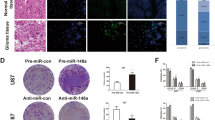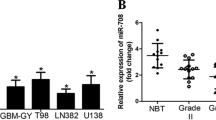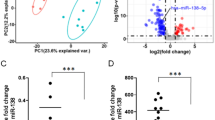Abstract
MicroRNAs (miRNAs) carry out post-transcriptional control of a multitude of cellular processes. Aberrant expression of miRNA can lead to diseases, including cancer. Gliomas are aggressive brain tumors that are thought to arise from transformed glioma-initiating neural stem cells (giNSCs). With the use of giNSCs and human glioblastoma cells, we investigated the function of miRNAs in gliomas. We identified pro-neuronal miR-128 as a candidate glioma tumor suppressor miRNA. Decreased expression of miR-128 correlates with aggressive human glioma subtypes. With a combination of molecular, cellular and in vivo approaches, we characterize miR-128's tumor suppressive role. miR-128 represses giNSC growth by enhancing neuronal differentiation. miR-128 represses growth and mediates differentiation by targeting oncogenic receptor tyrosine kinases (RTKs) epithelial growth factor receptor and platelet-derived growth factor receptor-α. Using an autochthonous glioma mouse model, we demonstrated that miR-128 repressed gliomagenesis. We identified miR-128 as a glioma tumor suppressor that targets RTK signaling to repress giNSC self-renewal and enhance differentiation.
This is a preview of subscription content, access via your institution
Access options
Subscribe to this journal
Receive 50 print issues and online access
$259.00 per year
only $5.18 per issue
Buy this article
- Purchase on Springer Link
- Instant access to full article PDF
Prices may be subject to local taxes which are calculated during checkout






Similar content being viewed by others
References
Bachoo RM, Maher EA, Ligon KL, Sharpless NE, Chan SS, You MJ et al. (2002). Epidermal growth factor receptor and Ink4a/Arf: convergent mechanisms governing terminal differentiation and transformation along the neural stem cell to astrocyte axis. Cancer Cell 1: 269–277.
Boockvar JA, Kapitonov D, Kapoor G, Schouten J, Counelis GJ, Bogler O et al. (2003). Constitutive EGFR signaling confers a motile phenotype to neural stem cells. Mol Cell Neurosci 24: 1116–1130.
Cheng LC, Pastrana E, Tavazoie M, Doetsch F . (2009). miR-124 regulates adult neurogenesis in the subventricular zone stem cell niche. Nat Neurosci 12: 399–408.
Ciafrè SA, Galardi S, Mangiola A, Ferracin M, Liu CG, Sabatino G et al. (2005). Extensive modulation of a set of microRNAs in primary glioblastoma. Biochem Biophys Res Commun 334: 1351–1358.
Conaco C, Otto S, Han J-J, Mandel G . (2006). Reciprocal actions of REST and a microRNA promote neuronal identity. Proc Natl Acad Sci USA 103: 2422–2427.
Conti A, Aguennouz MH, La Torre D, Tomasello C, Cardali S, Angileri F et al. (2009). miR-21 and 221 upregulation and miR-181b downregulation in human grade II–IV astrocytic tumors. J Neurooncol 93: 325–332.
Dai C, Celestino JC, Okada Y, Louis DN, Fuller GN, Holland EC . (2001). PDGF autocrine stimulation dedifferentiates cultured astrocytes and induces oligodendrogliomas and oligoastrocytomas from neural progenitors and astrocytes in vivo. Genes Dev 15: 1913–1925.
Doetsch F, Petreanu L, Caille I, Garcia-Verdugo J-M, Alvarez-Buylla A . (2002). EGF converts transit-amplifying neurogenic precursors in the adult brain into multipotent stem cells. Neuron 36: 1021–1034.
Filipowicz W, Bhattacharyya SN, Sonenberg N . (2008). Mechanisms of post-transcriptional regulation by microRNAs: are the answers in sight? Nat Rev Genet 9: 102–114.
Furnari FB, Fenton T, Bachoo RM, Mukasa A, Stommel JM, Stegh A et al. (2007). Malignant astrocytic glioma: genetics, biology, and paths to treatment. Genes Dev 21: 2683–2710.
Gangaraju VK, Lin H . (2009). MicroRNAs: key regulators of stem cells. Nat Rev Mol Cell Biol 10: 116–125.
Godlewski J, Nowicki MO, Bronisz A, Williams S, Otsuki A, Nuovo G et al. (2008). Targeting of the Bmi-1 oncogene/stem cell renewal factor by microRNA-128 inhibits glioma proliferation and self-renewal. Cancer Res 68: 9125–9130.
Hatley ME, Patrick DM, Garcia MR, Richardson JA, Bassel-Duby R, van Rooij E et al. (2010). Modulation of K-Ras-dependent lung tumorigenesis by microRNA-21. Cancer Cell 18: 282–293.
Huse JT, Brennan C, Hambardzumyan D, Wee B, Pena J, Rouhanifard SH et al. (2009). The PTEN-regulating microRNA miR-26a is amplified in high-grade glioma and facilitates gliomagenesis in vivo. Genes Dev 23: 1327–1337.
Jackson EL, Garcia-Verdugo JM, Gil-Perotin S, Roy M, Quinones-Hinojosa A, VandenBerg S et al. (2006). PDGFR±-positive B cells are neural stem cells in the adult SVZ that form glioma-like growths in response to increased PDGF signaling. Neuron 51: 187–199.
Krichevsky AM, King KS, Donahue CP, Khrapko K, Kosik KS . (2003). A microRNA array reveals extensive regulation of microRNAs during brain development. RNA 9: 1274–1281.
Krichevsky AM, Sonntag K-C, Isacson O, Kosik KS . (2006). Specific microRNAs modulate embryonic stem cell-derived neurogenesis. Stem Cells 24: 857–864.
Lewis BP, Shih Ih, Jones-Rhoades MW, Bartel DP, Burge CB . (2003). Prediction of mammalian microRNA targets. Cell 115: 787–798.
Liu C, Sage JC, Miller MR, Verhaak RG, Hippenmeyer S, Vogel H et al. (2011). Mosaic analysis with double markers reveals tumor cell of origin in glioma. Cell 146: 209–221.
Liu T, Papagiannakopoulos T, Puskar K, Qi S, Santiago F, Clay W et al. (2007). Detection of a microRNA signal in an in vivo expression set of mRNAs. PLoS One 2: e804.
Lu J, Getz G, Miska EA, Alvarez-Saavedra E, Lamb J, Peck D et al. (2005). MicroRNA expression profiles classify human cancers. Nature 435: 834–838.
Marumoto T, Tashiro A, Friedmann-Morvinski D, Scadeng M, Soda Y, Gage FH et al. (2009). Development of a novel mouse glioma model using lentiviral vectors. Nat Med 15: 110–116.
Mukasa A, Wykosky J, Ligon KL, Chin L, Cavenee WK, Furnari F . (2010). Mutant EGFR is required for maintenance of glioma growth in vivo, and its ablation leads to escape from receptor dependence. Proc Natl Acad Sci 107: 2616–2621.
: Network TCGA (2008). Comprehensive genomic characterization defines human glioblastoma genes and core pathways. Nature 455: 1061–1068.
Neveu P, Kye MJ, Qi S, Buchholz DE, Clegg DO, Sahin M et al. (2010). MicroRNA profiling reveals two distinct p53-related human pluripotent stem cell states. Cell Stem Cell 7: 671–681.
Papagiannakopoulos T, Shapiro A, Kosik KS . (2008). MicroRNA-21 targets a network of key tumor-suppressive pathways in glioblastoma cells. Cancer Res 68: 8164–8172.
Piccirillo SGM, Reynolds BA, Zanetti N, Lamorte G, Binda E, Broggi G et al. (2006). Bone morphogenetic proteins inhibit the tumorigenic potential of human brain tumour-initiating cells. Nature 444: 761–765.
Shih AH, Dai C, Hu X, Rosenblum MK, Koutcher JA, Holland EC . (2004). Dose-dependent effects of platelet-derived growth factor-B on glial tumorigenesis. Cancer Res 64: 4783–4789.
Singh SK, Hawkins C, Clarke ID, Squire JA, Bayani J, Hide T et al. (2004). Identification of human brain tumour initiating cells. Nature 432: 396–401.
Stiles CD, Rowitch DH . (2008). Glioma stem cells: a midterm exam. Neuron 58: 832–846.
Sugahara KN, Teesalu T, Karmali PP, Kotamraju VR, Agemy L, Greenwald DR et al. (2010). Coadministration of a tumor-penetrating peptide enhances the efficacy of cancer drugs. Science 328: 1031–1035.
Verhaak RGW, Hoadley KA, Purdom E, Wang V, Qi Y, Wilkerson MD et al. (2010). Integrated genomic analysis identifies clinically relevant subtypes of glioblastoma characterized by abnormalities in PDGFRA, IDH1, EGFR, and NF1. Cancer Cell 17: 98–110.
Visvanathan J, Lee S, Lee B, Lee JW, Lee S-K . (2007). The microRNA miR-124 antagonizes the anti-neural REST/SCP1 pathway during embryonic CNS development. Genes Dev 21: 744–749.
Wuchty S, Arjona D, Li AG, Kotliarov Y, Walling J, Ahn S et al. (2011). Prediction of associations between microRNAs and gene expression in glioma biology. PLoS One 6: e14681.
Xu N, Papagiannakopoulos T, Pan GJ, Thomson JA, Kosik KS . (2009). MicroRNA-145 regulates OCT4, SOX2, and KLF4 and represses pluripotency in human embryonic stem cells. Cell 137: 647–658.
Zhang Y, Chao T, Li R, Liu W, Chen Y, Yan X et al. (2009). MicroRNA-128 inhibits glioma cells proliferation by targeting transcription factor E2F3a. J Mol Med 87: 43–51.
Zhang Y, Zhang Y-f, Bryant J, Charles A, Boado RJ, Pardridge WM . (2004). Intravenous RNA interference gene therapy targeting the human epidermal growth factor receptor prolongs survival in intracranial brain cancer. Clin Cancer Res 10: 3667–3677.
Zheng H, Ying H, Yan H, Kimmelman AC, Hiller DJ, Chen A-J et al. (2008). p53 and Pten control neural and glioma stem/progenitor cell renewal and differentiation. Nature 455: 1129–1133.
Acknowledgements
We thank Israel Hernandez, Diego Piedrahita and Yngo Garcia for providing assistance with animal experiments, and Na Xu, Min Jeong Kye and Cecilia Conaco for scientific conversations and suggestions. Judith Czerny assisted in constructing target 3′-UTR constructs. Support for the project was from the WM Keck Foundation (KSK), the Miriam and Sheldon Adelson Medical Foundation (KSK), the National Science Foundation under grant No. PHY05-51164 (PN), the Myelin Repair Foundation (JCD and BAB), and the National Multiple Sclerosis Society (JCD and BAB). HZ work is supported by NIH grants (R55-CA136495, R01-CA136495). HZ is a Pew Scholar in Biomedical Sciences, supported by The Pew Charitable Trusts. DHR is an HHMI investigator.
Author information
Authors and Affiliations
Corresponding author
Ethics declarations
Competing interests
K.S.K. owns stock in and serves on the board of Minerva Biotechnologies corporation and is on the scientific advisory board of Nocira Pharmaceuticals.
Additional information
Supplementary Information accompanies the paper on the Oncogene website
Rights and permissions
About this article
Cite this article
Papagiannakopoulos, T., Friedmann-Morvinski, D., Neveu, P. et al. Pro-neural miR-128 is a glioma tumor suppressor that targets mitogenic kinases. Oncogene 31, 1884–1895 (2012). https://doi.org/10.1038/onc.2011.380
Received:
Revised:
Accepted:
Published:
Issue Date:
DOI: https://doi.org/10.1038/onc.2011.380



